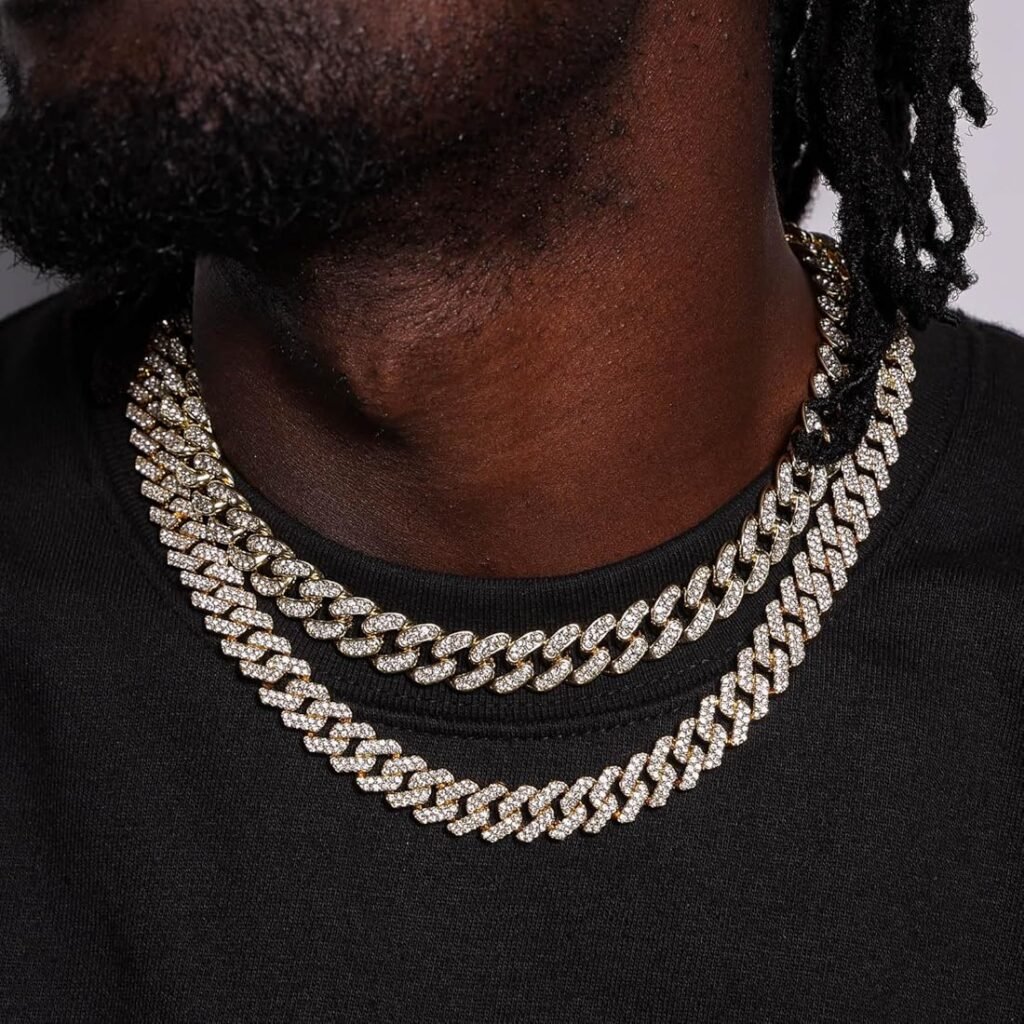When it comes to iced-out chains, most people focus on the shine—but there’s a lot more going on than just sparkle. One unexpected question people often ask is:
“Do iced-out chains make noise?”
The short answer is: Yes, sometimes they do. But why that happens—and what it says about your piece—can tell you a lot about its quality, construction, and overall vibe.
In this blog, we’ll answer that and dive into other wild things you probably didn’t know about iced-out chains.
🔊 1. Do Iced Out Chains Make Noise?
The Real Talk:
Yes, iced-out chains can make a subtle jingling or clinking sound, especially when you walk, dance, or layer multiple pieces together. However, not all chains do this.
Why Chains Make Noise:
- Stone Settings: If stones are not tightly set, they may rattle slightly.
- Link Style: Looser, heavier links (like Miami Cubans or Franco chains) may clack together.
- Layering: Stacking several chains causes contact noise between metal surfaces.
- Metal Type: Stainless steel or silver-plated pieces tend to make more noticeable sound than solid gold, which is denser.
Is Noise a Bad Thing?
Not necessarily. Some people actually like that slight ice chatter—it adds to the swagger. But if a chain sounds too noisy, it might mean low craftsmanship or loose stones, especially in replicas.
🧊 2. Why Do Iced Out Chains Feel So Heavy?
Another surprise: iced-out chains are heavier than you expect. That’s because:
- The stones add mass, especially if you’re using moissanite or CZ.
- The metal base (silver, gold, stainless steel) also contributes to the bulk.
- Large links or dense custom pendants add to the overall drip weight.
A quality 18-inch, 12mm iced Cuban link chain with CZ can weigh 150–300 grams. So if your neck feels sore after a long night out—yeah, the ice is working.
🔍 3. Not All Ice Is the Same
In 2025, not all “ice” is real. Here’s what people might not know:
- CZ (Cubic Zirconia): Great shine, but scratches and clouds faster.
- Moissanite: Passes diamond testers, insane brilliance, trending hard.
- Lab Diamonds: Technically real diamonds, but much more affordable.
- Rhinestones or Acrylic Stones: Used in ultra-low-end chains—easy to spot.
The lesson: Always ask what kind of stones are in the chain. It could make a $400 difference.
💧 4. What Happens If Your Chain Gets Wet?
A common myth is that iced-out chains can’t handle water. Not true—it depends on the material.
If your chain is:
- Solid Gold or Silver + Moissanite = Water safe
- Gold-Plated over Brass + CZ = Risk of tarnishing, glue loosening
- Stainless Steel = Water-resistant, but may fade over time
Pro Tip: Don’t swim or shower with cheap iced-out chains. Water won’t kill it right away, but long-term exposure can ruin the plating and dull the stones.
🛠️ 5. Can You Fix a Loose Stone?
Yes, but not always easily.
- Tightly set stones (prong or pave) can be reset by a jeweler.
- Glued stones (common in cheap chains) may fall out and be harder to replace.
- If you’re buying online, look for stone warranty coverage or repair options.
This is one reason moissanite or higher-end CZ chains are worth the price—they usually come with better craftsmanship.
🎥 6. Chains in Music Videos vs. Real Life
On screen, iced-out chains look flawless—but here’s what you didn’t see:
- Many artists wear borrowed or staged pieces for photo/video shoots.
- Lighting makes stones sparkle harder than in natural light.
- Some chains are even diamond simulants or superclones—just for the camera.
So if your chain doesn’t shine like Lil Baby’s in your selfie—don’t stress. Even big names use tricks of the trade.
🔒 7. Magnetic Clasps & Hidden Features
Some newer iced-out chains come with magnetic or invisible lock clasps that are smoother, more seamless, and harder to pop off.
Bonus features you might not know about:
- Lockable safety latches to prevent slipping during dance/performance
- Custom engraving hidden inside links
- Matching bracelet connectors for wrist-to-neck drip sets
👃 8. Do Some Cheap Chains Smell?
Surprisingly, yes.
Low-end plated chains (especially with brass or nickel alloy bases) may emit a faint metallic or chemical odor—especially in humid climates or with skin oils.
This is more common in chains bought off low-cost platforms. Always look for chains made with 316L stainless steel, vermeil, or sterling silver as a base for better hygiene and comfort.
🔥 9. Your Chain Can Affect Your Skin
If your iced-out chain causes:
- Green or black neck stains
- Itching or redness
- Breakouts or rash
You’re likely dealing with cheap base metal, or a fading gold plating. Switch to hypoallergenic metals like real silver or stainless steel for a safer flex.
💡 Final Thoughts: Your Ice, Your Rules
So—do iced-out chains make noise?
Sometimes—but that’s just part of the personality.
What matters more is:
- Quality over quantity
- Knowing your materials
- And flexing in a way that’s true to your style.
Iced-out chains are more than just hip hop jewelry—they’re a culture, a statement, and a vibe. The deeper you go, the more you’ll discover that the little things—like the sound, the weight, the setting—tell the real story of your drip.







